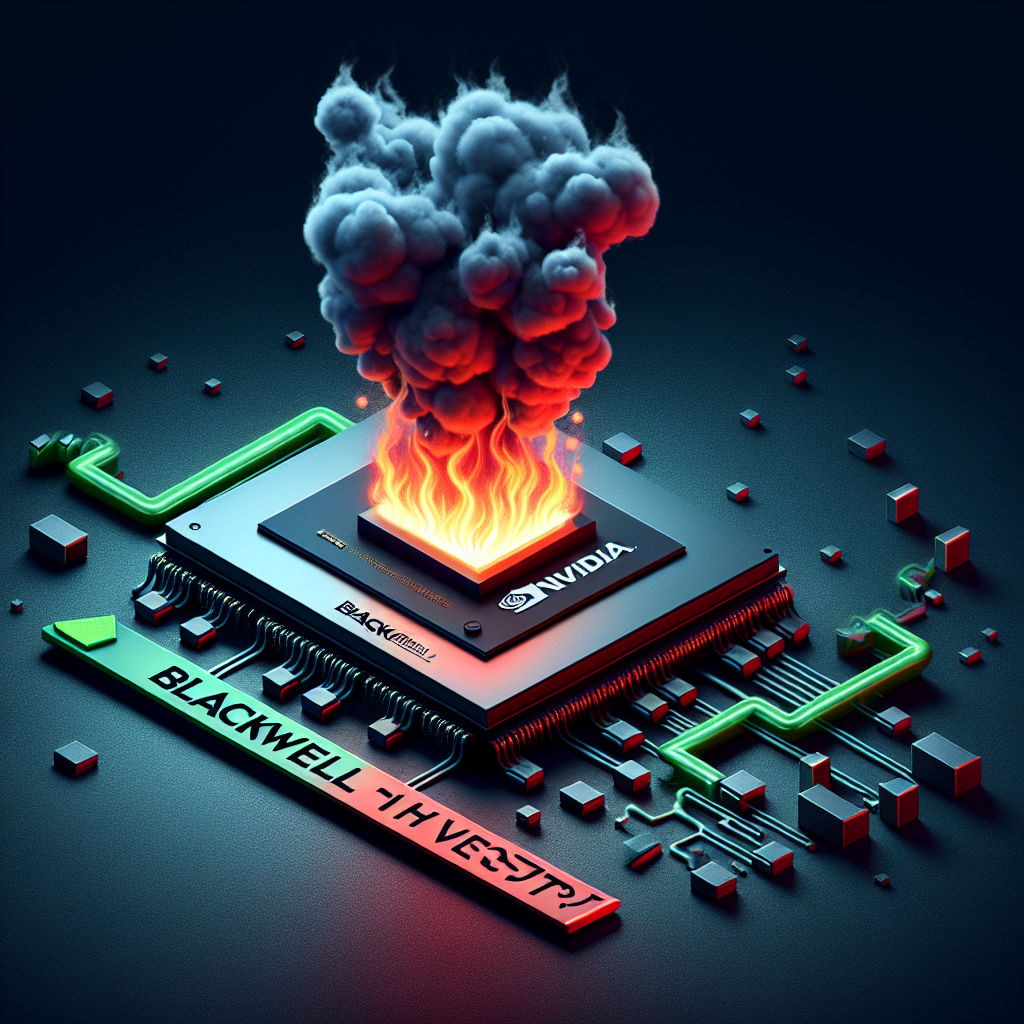“Navigate the Heat: Nvidia’s Blackwell Challenge and Your Investment Decision”
Introduction
Nvidia, a leading player in the semiconductor industry, is currently facing scrutiny over reports of overheating issues with its latest products, specifically the Blackwell series of GPUs. As the company approaches its upcoming earnings report, investors are keenly observing how these technical challenges might impact Nvidia’s financial performance and market position. The overheating concerns have raised questions about the reliability and long-term viability of Nvidia’s cutting-edge technology, potentially influencing investor sentiment. As the earnings date approaches, potential investors are weighing the risks and opportunities associated with Nvidia’s stock, considering both the company’s historical resilience and the immediate challenges posed by the Blackwell overheating issue.
Understanding Nvidia’s Blackwell Architecture: What Went Wrong?
Nvidia, a leading name in the semiconductor industry, has long been at the forefront of graphics processing unit (GPU) innovation. As the company prepares to release its latest earnings report, attention has shifted to its new Blackwell architecture, which has been making headlines for an unexpected reason: overheating issues. This development has raised questions about the architecture’s design and its potential impact on Nvidia’s market performance, leaving investors to ponder whether now is the right time to invest in the tech giant.
The Blackwell architecture, named after the renowned mathematician David Blackwell, was anticipated to be a game-changer in the GPU market. It promised significant improvements in performance and efficiency, building on the success of Nvidia’s previous architectures. However, reports of overheating have cast a shadow over these expectations. The issue appears to stem from the architecture’s power management system, which, while designed to optimize performance, has inadvertently led to excessive heat generation under certain conditions.
Understanding the root cause of this overheating problem requires a closer look at the architecture’s design. Blackwell was engineered to push the boundaries of computational power, incorporating more transistors and advanced cooling solutions. However, the increased density of components has resulted in higher thermal output, which, when not adequately managed, can lead to overheating. This is particularly concerning for high-performance applications, such as gaming and data centers, where sustained processing power is crucial.
In response to these challenges, Nvidia has been working diligently to address the overheating issues. The company has initiated a series of firmware updates aimed at optimizing the power management system and improving thermal regulation. Additionally, Nvidia is collaborating with hardware partners to enhance cooling solutions, ensuring that the architecture can operate within safe temperature ranges. These efforts demonstrate Nvidia’s commitment to maintaining its reputation for reliability and performance.
Despite these proactive measures, the overheating issue has inevitably sparked concerns among investors. The potential impact on Nvidia’s financial performance cannot be ignored, especially as the company prepares to release its earnings report. Analysts are closely monitoring how the Blackwell architecture’s challenges might affect Nvidia’s revenue and market share. However, it is important to consider the broader context of Nvidia’s business strategy and market position.
Nvidia has a history of overcoming technical challenges and emerging stronger. The company’s robust research and development capabilities, coupled with its strategic partnerships, provide a solid foundation for addressing the current issues. Moreover, the demand for GPUs continues to grow, driven by trends such as artificial intelligence, machine learning, and the metaverse. These factors suggest that Nvidia remains well-positioned to capitalize on future opportunities, despite the temporary setback posed by the Blackwell architecture.
For potential investors, the decision to invest in Nvidia hinges on weighing the short-term risks against the long-term potential. While the overheating issue is a legitimate concern, Nvidia’s track record of innovation and market leadership cannot be overlooked. As the company works to resolve the current challenges, it is likely to continue playing a pivotal role in shaping the future of technology. Therefore, investors should consider their risk tolerance and investment horizon when deciding whether to invest in Nvidia at this juncture. Ultimately, Nvidia’s ability to navigate the Blackwell overheating issue will be a testament to its resilience and adaptability in an ever-evolving industry.
The Impact of Overheating Issues on Nvidia’s Market Performance
Nvidia, a leading player in the semiconductor industry, has recently encountered a significant challenge with its Blackwell series of graphics processing units (GPUs). Reports of overheating issues have surfaced, raising concerns among consumers and investors alike. As the company approaches its earnings announcement, the implications of these technical difficulties on Nvidia’s market performance are under scrutiny. Understanding the potential impact of these overheating issues is crucial for investors considering their position in Nvidia.
The overheating problem with the Blackwell GPUs has emerged at a critical juncture for Nvidia. The company has been riding a wave of success, driven by the growing demand for high-performance computing solutions in sectors such as artificial intelligence, gaming, and data centers. However, the overheating issue threatens to disrupt this momentum. Consumers have reported that the GPUs are reaching temperatures beyond their operational limits, leading to system instability and, in some cases, hardware damage. This has prompted Nvidia to initiate investigations and consider potential recalls or software updates to mitigate the problem.
The timing of this issue is particularly concerning as Nvidia prepares to release its quarterly earnings report. Investors are keenly aware that any negative publicity or financial implications stemming from the overheating problem could affect the company’s stock performance. Historically, Nvidia has demonstrated resilience in the face of technical challenges, often leveraging its robust research and development capabilities to address issues swiftly. However, the current situation presents a unique challenge, as it involves a flagship product line that is integral to Nvidia’s growth strategy.
In assessing the potential impact on Nvidia’s market performance, it is essential to consider both short-term and long-term effects. In the short term, the overheating issue may lead to a decline in consumer confidence, resulting in reduced sales and potential financial losses. Additionally, the cost of addressing the problem, whether through recalls or warranty claims, could impact Nvidia’s profit margins. These factors may contribute to increased volatility in Nvidia’s stock price as investors react to unfolding developments.
On the other hand, Nvidia’s long-term prospects remain promising, provided the company can effectively resolve the overheating issue. Nvidia has a track record of innovation and adaptability, which could enable it to overcome this setback and maintain its competitive edge. The company’s strong relationships with major technology partners and its commitment to advancing GPU technology position it well for future growth. Moreover, the demand for high-performance computing solutions is expected to continue rising, offering Nvidia ample opportunities to capitalize on its expertise.
For investors contemplating their position in Nvidia, the current situation presents both risks and opportunities. While the overheating issue poses a short-term challenge, Nvidia’s underlying strengths and market potential should not be overlooked. Investors should closely monitor the company’s response to the problem and its ability to reassure consumers and stakeholders. Additionally, keeping an eye on Nvidia’s earnings report will provide valuable insights into how the company is navigating this challenge and its overall financial health.
In conclusion, the overheating issue with Nvidia’s Blackwell GPUs is a significant concern that could impact the company’s market performance in the short term. However, Nvidia’s history of resilience and innovation suggests that it has the capacity to address this challenge effectively. Investors should weigh the immediate risks against the long-term potential, considering both the company’s response to the issue and the broader market dynamics. As Nvidia approaches its earnings announcement, the unfolding developments will be crucial in determining whether it remains a compelling investment opportunity.
Nvidia’s Response to Blackwell Overheating: A Closer Look
Nvidia, a leading name in the semiconductor industry, has recently found itself under scrutiny due to reports of overheating issues with its latest Blackwell GPUs. As the company approaches its earnings announcement, investors and consumers alike are keenly observing how Nvidia addresses these concerns. The Blackwell series, anticipated to be a game-changer in the realm of graphics processing, has been met with high expectations. However, the overheating issue has cast a shadow over its launch, prompting questions about the potential impact on Nvidia’s market performance and investor confidence.
In response to these concerns, Nvidia has taken a proactive approach. The company has acknowledged the overheating reports and has committed to investigating the root causes. This transparency is crucial, as it not only reassures consumers but also demonstrates Nvidia’s dedication to maintaining its reputation for quality and innovation. By addressing the issue head-on, Nvidia aims to mitigate any potential damage to its brand and ensure that the Blackwell series lives up to its promise.
To further assuage concerns, Nvidia has initiated a series of software updates designed to optimize the performance of the Blackwell GPUs. These updates are intended to enhance thermal management and prevent overheating, thereby improving the overall user experience. Additionally, Nvidia is working closely with hardware partners to ensure that any necessary design adjustments are implemented swiftly. This collaborative effort underscores Nvidia’s commitment to delivering a reliable product and maintaining strong relationships with its partners.
Moreover, Nvidia’s response to the overheating issue is indicative of its broader strategy to prioritize customer satisfaction and product excellence. By swiftly addressing the problem, Nvidia not only protects its current market position but also reinforces its long-term growth prospects. This approach is particularly important as the company prepares to release its earnings report, which will provide further insight into its financial health and strategic direction.
As investors consider whether to invest in Nvidia amidst these developments, several factors should be taken into account. Firstly, Nvidia’s track record of innovation and market leadership suggests that the company is well-equipped to overcome this challenge. The swift response to the overheating issue demonstrates Nvidia’s agility and commitment to quality, which are critical attributes in the fast-paced technology sector. Furthermore, the company’s strong financial performance in recent quarters indicates a solid foundation that can support continued growth and innovation.
However, potential investors should also be mindful of the risks associated with the current situation. The overheating issue, if not resolved effectively, could lead to reputational damage and impact consumer trust. Additionally, any delays in addressing the problem could affect Nvidia’s sales and market share, particularly if competitors seize the opportunity to capitalize on the situation.
In conclusion, Nvidia’s response to the Blackwell overheating issue reflects its commitment to quality and customer satisfaction. While the situation presents certain risks, the company’s proactive measures and strong market position suggest that it is well-prepared to navigate these challenges. As Nvidia approaches its earnings announcement, investors should weigh the potential risks and rewards, considering both the company’s historical performance and its ability to address current issues effectively. Ultimately, Nvidia’s handling of the Blackwell situation will be a key factor in determining its future trajectory and attractiveness as an investment opportunity.
Analyzing Nvidia’s Earnings Forecast Amidst Technical Challenges

Nvidia, a leading player in the semiconductor industry, is currently navigating a challenging landscape as it approaches its upcoming earnings report. The company, renowned for its cutting-edge graphics processing units (GPUs), is facing a significant technical issue with its latest Blackwell series. Reports of overheating problems have surfaced, raising concerns among investors and industry analysts alike. This development comes at a critical juncture, as Nvidia’s financial performance is under scrutiny, and stakeholders are eager to understand the potential impact on the company’s earnings forecast.
The overheating issue with the Blackwell series has sparked a flurry of discussions within the tech community. Users have reported that the GPUs tend to overheat during intensive tasks, leading to performance throttling and, in some cases, hardware damage. This has prompted Nvidia to initiate an investigation into the root cause of the problem. While the company has assured customers that it is working diligently to address the issue, the situation has inevitably cast a shadow over its reputation for reliability and innovation.
As Nvidia prepares to release its earnings report, the market is keenly observing how this technical challenge might influence its financial outlook. Historically, Nvidia has demonstrated resilience in the face of adversity, often leveraging its robust research and development capabilities to overcome obstacles. However, the current scenario presents a unique set of challenges, as the overheating issue could potentially affect sales and customer trust. Consequently, investors are weighing the potential risks and rewards of maintaining or initiating positions in Nvidia’s stock.
In light of these developments, it is essential to consider Nvidia’s broader market position and strategic initiatives. The company has been a dominant force in the GPU market, with its products powering a wide range of applications, from gaming to artificial intelligence and data centers. This diversification has been a key driver of Nvidia’s growth, providing a buffer against isolated technical setbacks. Moreover, Nvidia’s ongoing investments in emerging technologies, such as autonomous vehicles and machine learning, underscore its commitment to long-term innovation and market leadership.
Despite the current technical challenges, Nvidia’s financial fundamentals remain strong. The company has consistently delivered impressive revenue growth, driven by robust demand for its products across various sectors. Additionally, Nvidia’s strategic partnerships and acquisitions have bolstered its competitive edge, positioning it well for future expansion. As such, while the overheating issue is a cause for concern, it is unlikely to derail Nvidia’s overall growth trajectory.
For potential investors, the decision to invest in Nvidia amidst these technical challenges requires a careful assessment of both short-term risks and long-term opportunities. On one hand, the overheating issue could lead to temporary disruptions in sales and customer satisfaction. On the other hand, Nvidia’s track record of innovation and market leadership suggests that it is well-equipped to address these challenges and emerge stronger.
In conclusion, Nvidia’s upcoming earnings report will be a critical indicator of how the company is managing the Blackwell overheating issue and its broader financial performance. While the technical challenges present a hurdle, Nvidia’s strong market position and commitment to innovation provide a solid foundation for future growth. Investors should closely monitor the company’s response to the overheating problem and consider the potential long-term benefits of investing in a technology leader with a proven ability to adapt and thrive in a dynamic industry.
Investment Strategies: Navigating Nvidia’s Current Challenges
Nvidia, a leading player in the semiconductor industry, has recently encountered a significant challenge that could impact its market performance and investor sentiment. The company, renowned for its cutting-edge graphics processing units (GPUs) and artificial intelligence (AI) technologies, is facing an overheating issue with its latest Blackwell series of GPUs. This development comes at a critical juncture, as Nvidia is poised to release its quarterly earnings report. Consequently, investors are left pondering whether this is a temporary setback or a sign of deeper issues within the company.
The overheating problem with the Blackwell GPUs has raised concerns among consumers and industry experts alike. Reports suggest that the GPUs are experiencing thermal management issues, leading to performance throttling and, in some cases, hardware damage. This has prompted Nvidia to initiate an investigation into the root cause of the problem, with a promise to address it swiftly. However, the timing of this issue is particularly unfortunate, as it coincides with the company’s earnings announcement, a period when investor scrutiny is at its peak.
In light of these developments, potential investors are faced with a dilemma. On one hand, Nvidia’s track record of innovation and market leadership cannot be overlooked. The company has consistently delivered strong financial results, driven by its dominance in the gaming and AI sectors. Moreover, Nvidia’s strategic partnerships and acquisitions have positioned it well for future growth, particularly in the burgeoning fields of autonomous vehicles and data centers. These factors suggest that Nvidia remains a formidable player in the tech industry, with significant long-term potential.
On the other hand, the Blackwell overheating issue introduces an element of uncertainty. If not resolved promptly, it could lead to a loss of consumer confidence and a potential decline in sales. Furthermore, the financial implications of addressing the problem, such as product recalls or warranty claims, could impact Nvidia’s profitability in the short term. Investors must weigh these risks against the company’s historical resilience and ability to overcome challenges.
To navigate this complex situation, investors should consider a few key strategies. First, it is essential to closely monitor Nvidia’s response to the overheating issue. The company’s ability to effectively communicate its plan for resolution and implement corrective measures will be crucial in restoring confidence. Additionally, investors should pay attention to the upcoming earnings report, as it will provide valuable insights into Nvidia’s financial health and future outlook.
Furthermore, diversification remains a prudent approach for managing risk. While Nvidia’s potential for growth is undeniable, relying solely on one company can expose investors to unnecessary volatility. By diversifying their portfolios across different sectors and asset classes, investors can mitigate the impact of any single company’s challenges.
In conclusion, Nvidia’s current predicament with the Blackwell overheating issue presents both challenges and opportunities for investors. While the situation introduces a degree of uncertainty, the company’s strong fundamentals and history of innovation suggest that it has the capacity to overcome this hurdle. By staying informed and adopting a diversified investment strategy, investors can navigate Nvidia’s current challenges while positioning themselves for potential long-term gains. As the company works to resolve the issue and release its earnings report, the coming weeks will be pivotal in determining Nvidia’s trajectory and its attractiveness as an investment opportunity.
Comparing Nvidia’s Blackwell to Competitors: A Technical Perspective
Nvidia, a leader in the graphics processing unit (GPU) market, has recently encountered a significant challenge with its latest Blackwell series. As the company approaches its earnings report, the overheating issue associated with Blackwell GPUs has become a focal point for both investors and industry analysts. This development raises questions about Nvidia’s competitive standing, particularly when compared to its rivals in the GPU market. To understand the implications of this issue, it is essential to examine the technical aspects of Blackwell and how it stacks up against competitors.
The Blackwell series, named after the renowned mathematician David Blackwell, was anticipated to be a game-changer in the GPU industry. Designed to deliver unprecedented performance, these GPUs were expected to cater to the growing demands of artificial intelligence, gaming, and data centers. However, reports of overheating have cast a shadow over these expectations. The overheating problem not only affects the performance of the GPUs but also raises concerns about their long-term reliability and efficiency. This issue is particularly troubling given the high-performance benchmarks that Nvidia had promised.
In contrast, competitors such as AMD and Intel have been making strides with their own GPU offerings. AMD’s latest RDNA architecture has been praised for its energy efficiency and robust performance, making it a formidable competitor in the market. Similarly, Intel’s foray into the discrete GPU space with its Arc series has shown promise, particularly in terms of thermal management and power consumption. These advancements by Nvidia’s competitors highlight the importance of balancing performance with thermal efficiency, a balance that Blackwell currently struggles to achieve.
The overheating issue with Blackwell can be attributed to several technical factors. One primary concern is the increased power draw required to achieve the high performance levels that Nvidia has targeted. This power draw results in higher thermal output, which, if not managed effectively, can lead to overheating. Additionally, the architectural design of Blackwell, while innovative, may have inadvertently contributed to thermal challenges. The densely packed transistors, designed to enhance computational capabilities, also generate significant heat, necessitating advanced cooling solutions that may not be fully optimized.
Despite these challenges, it is important to consider Nvidia’s track record of innovation and problem-solving. The company has historically demonstrated an ability to address technical issues and deliver products that set industry standards. Moreover, Nvidia’s investment in research and development suggests that solutions to the overheating problem may be forthcoming. This potential for resolution, coupled with Nvidia’s strong market position, may reassure some investors.
However, the timing of this issue is critical. With the earnings report on the horizon, Nvidia’s ability to address the overheating problem swiftly and effectively will be closely scrutinized. Investors will be keen to see how the company plans to mitigate the impact of this issue on its financial performance and market share. Furthermore, Nvidia’s response will likely influence its competitive standing, particularly as AMD and Intel continue to advance their own technologies.
In conclusion, while the Blackwell overheating issue presents a significant challenge for Nvidia, it also serves as a reminder of the complexities involved in pushing the boundaries of GPU technology. As the company navigates this hurdle, potential investors must weigh the risks associated with the current technical difficulties against Nvidia’s history of innovation and market leadership. Ultimately, the decision to invest will depend on one’s confidence in Nvidia’s ability to resolve these issues and maintain its competitive edge in the rapidly evolving GPU landscape.
Long-term Implications of Nvidia’s Overheating Issues on Stock Value
Nvidia, a leading player in the semiconductor industry, has recently encountered a significant challenge with its latest Blackwell series of graphics processing units (GPUs). Reports of overheating issues have surfaced, raising concerns among investors and consumers alike. As the company approaches its earnings announcement, the implications of these technical difficulties on Nvidia’s long-term stock value warrant careful consideration. Understanding the potential impact of these overheating issues requires an examination of both the immediate and future consequences for Nvidia’s market position and investor confidence.
Initially, the overheating problem poses a direct threat to Nvidia’s reputation for producing high-performance, reliable GPUs. The Blackwell series, anticipated to be a game-changer in the graphics card market, now faces scrutiny that could dampen consumer enthusiasm and sales. This situation is particularly concerning given the competitive landscape, where rivals such as AMD and Intel are eager to capitalize on any missteps by Nvidia. Consequently, the immediate financial impact could be reflected in the upcoming earnings report, potentially leading to a short-term dip in stock value.
However, it is essential to consider Nvidia’s track record of innovation and resilience in the face of technical challenges. Historically, the company has demonstrated an ability to address product issues effectively, often emerging stronger and more competitive. For instance, past overheating problems with earlier GPU models were swiftly resolved through firmware updates and design modifications. This capability to adapt and improve suggests that Nvidia may overcome the current Blackwell overheating issue, thereby mitigating long-term damage to its brand and financial performance.
Moreover, Nvidia’s strategic positioning in the broader technology ecosystem provides a buffer against isolated product setbacks. The company’s leadership in artificial intelligence (AI), data centers, and autonomous vehicles underscores its diversified revenue streams, which can help absorb the impact of any single product line’s underperformance. This diversification is a critical factor for investors to consider, as it reduces the overall risk associated with Nvidia’s stock. Furthermore, the growing demand for AI and machine learning applications continues to drive the need for advanced GPUs, ensuring a robust market for Nvidia’s products despite temporary setbacks.
In addition to its diversified portfolio, Nvidia’s strong research and development capabilities are likely to play a crucial role in addressing the overheating issue. The company’s commitment to innovation is evident in its substantial investment in R&D, which not only facilitates the resolution of current technical problems but also positions Nvidia to lead future technological advancements. This forward-looking approach is a positive indicator for long-term investors, as it suggests that Nvidia is well-equipped to maintain its competitive edge in the rapidly evolving tech industry.
While the immediate impact of the Blackwell overheating issue may cause some volatility in Nvidia’s stock value, the company’s overall resilience and strategic advantages suggest that the long-term implications may be less severe. Investors should weigh the potential short-term fluctuations against Nvidia’s proven ability to navigate challenges and capitalize on emerging opportunities. As the company prepares to release its earnings report, the focus will likely be on how effectively Nvidia addresses the overheating problem and communicates its strategy for future growth. Ultimately, for those considering an investment in Nvidia, the decision should be informed by a comprehensive assessment of both the current challenges and the company’s long-term prospects in the technology sector.
Q&A
1. **What is the Blackwell Overheating Issue?**
The Blackwell Overheating Issue refers to reported thermal management problems in Nvidia’s upcoming Blackwell series GPUs, which could potentially affect performance and reliability.
2. **How might this issue impact Nvidia’s earnings?**
If unresolved, the overheating issue could lead to increased returns, warranty claims, and a potential decline in sales, negatively impacting Nvidia’s earnings.
3. **What is Nvidia’s response to the overheating issue?**
Nvidia is likely investigating the root cause and working on solutions, such as firmware updates or hardware revisions, to address the overheating problem.
4. **How has the market reacted to the overheating news?**
The market reaction may include a temporary dip in Nvidia’s stock price due to investor concerns over potential impacts on sales and reputation.
5. **What are analysts saying about Nvidia’s stock in light of this issue?**
Analysts may have mixed opinions, with some downgrading their outlook due to the risks, while others remain optimistic about Nvidia’s long-term prospects.
6. **What factors should investors consider before investing in Nvidia now?**
Investors should consider the potential impact of the overheating issue, Nvidia’s ability to resolve it, the company’s overall financial health, and the competitive landscape in the GPU market.
7. **Is it a good time to invest in Nvidia despite the overheating issue?**
This depends on individual risk tolerance and investment strategy. Some may see it as a buying opportunity if they believe Nvidia will effectively address the issue, while others may prefer to wait for more clarity.
Conclusion
Nvidia’s recent overheating issue with its Blackwell GPUs has raised concerns among investors, especially as the company approaches its earnings report. While Nvidia has a strong track record of innovation and market leadership in the semiconductor industry, the overheating problem could impact short-term performance and consumer confidence. Potential investors should weigh the company’s ability to address and resolve these technical challenges against its long-term growth prospects and market position. It may be prudent to monitor Nvidia’s response to the issue and its upcoming earnings report before making an investment decision.





